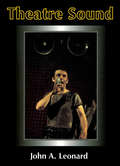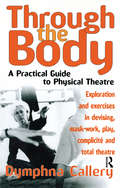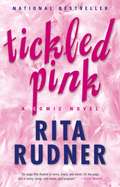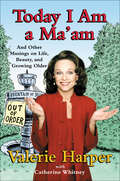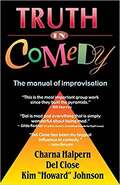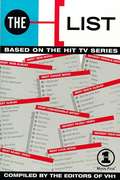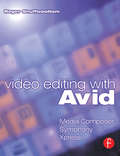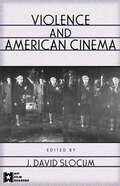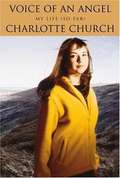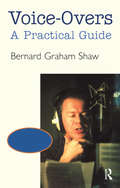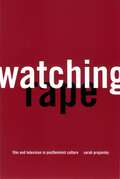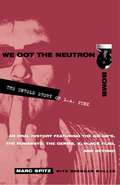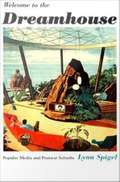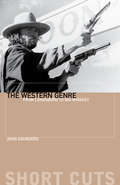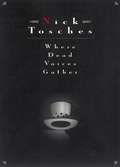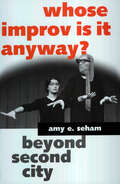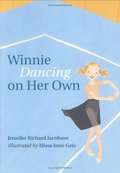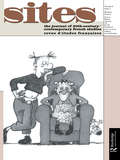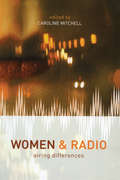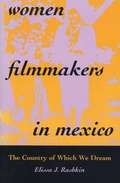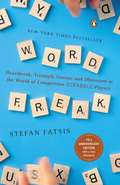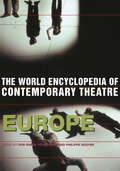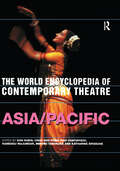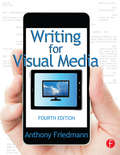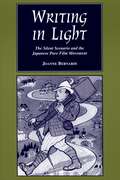- Table View
- List View
Theatre Sound
by John A. LeonardTheatre Sound includes a brief history of the use of sound in the theatre, discussions of musicals, sound effects, and the recording studio, and even an introduction to the physics and math of sound design. A bibliography and online reference section make this the new essential work for students of theatre and practicing sound designers.
Through the Body: A Practical Guide to Physical Theatre
by Dymphna CalleryIn Through the Body, Dymphna Callery introduces the reader to the principles behind the work of key practitioners of 20th-century theater including Artaud, Grotowski, Brook and Lecoq. She offers exercises that turn their theories into practice and explore their principles in action.
Today I Am a Ma'am: and Other Musings On Life, Beauty, and Growing Older
by Valerie Harper Catherine WhitneyValerie Harper has a message for women of a certain age: "Work those laugh lines!" With the irreverence and wit that made her one of television's most beloved personalities, Harper (a.k.a. Rhoda Morgenstern) takes on those phony "fabulous at 50" books written by women whose skin is free of laugh lines and who wouldn't know a cellulite pocket if it bit them on the backside. With her trademark shoot-from-the-hip, call-'em-like-she-sees-'em style, she helps women celebrate, with humor and grace, what it means to be middle aged.Harper's essays explore the treacherous terrain women must travel -- from the tyrannies of fashion to the unmentionables of menopause. She tackles the most perplexing questions of the day: If you wear a size zero, do you exist? Would menopause be revered if it happened to men? Do calories count if you eat standing up? Are dressing rooms fitted with fun house mirrors? Today I Am a Ma'am is the perfect antidote to the youth obsession of our culture, offered by America's most reliable girlfriend. It is Humor Replacement Therapy for midlife women, a book you can pick up when ever you need a laugh or a reminder that midriff drift is not the end of the world.
Truth in Comedy: The Manual of Improvisation
by Charna Halpern Del Close Mike Myers Arthur L. Zapel Kim H. JohnsonWant to learn the improv techniques that helped Mike Myers, Chris Farley, John Belushi, and many others along the road to TV and film stardom? Then let two esteemed founders of long-form improvisational theatre, Del Close and Charna Halpern, teach you the "Harold." <p><p> This groundbreaking acting exercise emphasizes pattern recognition and subversion of the audience s expectations, which are important factors for making people laugh without ever telling a joke. It involves six to seven players and many kinds of scenes: games, monologues, songs, skits and more, all of which are bound to keep both actors and audience members guessing. <p><p> The Harold is non-linear entertainment that remembers everything and wastes nothing the key to successful improvising and has become a standard in comedy clubs and improv theatres around the globe.
VH1: The List
by Wendy WalkerEver since VH1's The List started recruiting celebrities for on-air debates over everything from the Greatest Male Rock Star to the Most Overrated Song, people everywhere have been demanding their own vote. Now, in this addictive and conversation-sparking book of lists, the general populace has spoken. Here are some of the results, in more than 70 categories of great import, including: Artist You Most Want to Spend the Night With; Sexiest Teen Idol; Rock's Most Significant Moment Best Album; Best TV Theme Song; Most Fashionable Artist; Best Lead Guitarist; Best Music Video; Featuring celebrity lists from the likes of James Brown, Melissa Etheridge, Stewart Copeland of The Police, and Gavin Rossdale of Bush, celebrity quotes, a "Just Missed" section, and space at the back of the book for you own write-in lists, VH1: The List is a fun, interactive book- perfect for the opinionated pop-culture enthusiast in all of us.
Video Editing with Avid: Media Composer, Symphony, Xpress
by Roger ShufflebottomThis is the first comprehensive guide to editing on Avid from a PAL standpoint, also including NTSC information where appropriate, making this book a worldwide manual.If you are already using Media Composer, Symphony, or Xpress and want to improve and consolidate your basic methods, or if you need to learn these systems from scratch, then this book is for you. This invaluable reference source explains, from beginner to intermediate level, the similarities and differences of these three packages and will ensure you get the most out of your Avid system. Based on his experience as a film and video editor and trainer, Roger Shufflebottom imparts all the information you need in a clear, accurate and easy to follow format. He provides a comprehensive guide to all the main editing tools of Media Composer, Symphony and Xpress. The text covers Media Composer versions 7-10, Xpress versions 2-4, and Symphony versions 1-3. Extra information is also included on Media Composer version 10.5, Symphony version 3.5 and Xpress version 4.5. Specific Apple Mac and Windows NT information is included.Moving beyond basic editing, 2D effects, 3D effects and graphic import are explained in detail. By working through the text you will be able to complete an Avid project competently and intuitively and you will learn some efficient and powerful working techniques.Roger Shufflebottom has been an editor since 1974, began training in 1993 and has run courses for major broadcasters including the BBC, Carlton, BskyB, Pearson Television and the American Forces Network as well as many facility companies. He is an Avid Certified Instructor and has written many articles for 'Avid User' magazine.
Violence and American Cinema: Violence And American Cinema (AFI Film Readers)
by J. David SlocumFirst Published in 2001. Routledge is an imprint of Taylor & Francis, an informa company.
Voice Of An Angel: My Life (So Far)
by Charlotte ChurchAt fifteen, Charlotte Church has already lived a celebrated life. A world-famous singer who has sung before the Queen, a president, and the Pope, as well as sold millions of albums, charmed TV talk show hosts, and appeared on the covers of dozens of magazines, she has even acted in a top-rated TV show (The media's favorite question seems to be "Is that really you singing") Yet Charlotte, who was the youngest artist ever to have a debut album on the Billboard charts, still finds time to go to school, get good grades, and even go shopping with her friends in her hometown of Cardiff, Wales. Now you'll go behind the scenes to meet more than just Charlotte the internationally known soprano. You'll get to know Charlotte the daughter of Maria and James Church, who travels everywhere with her mum and dad ...the beloved granddaughter of Nan and Bampy, who thrills to her grandfather's stories about the rock band he had when the Beatles first hit the charts...and Charlotte the niece of Caroline Cooper, who still enjoys singing with the aunt she credits as her biggest musical influence. Charlotte seems like any other teenager, and she is-except for her astonishing voice. She wants her fans to know what she is really like and to meet her best friends...as well as travel with her on a typical tour and know what it is like to sing with Plãcido Domingo or ride on a float-in the rain!-in Macy's Thanksgiving Day Parade. In a voice as down to earth as her singing is angelic, she candidly talks about growing up in the limelight, the valuable lessons she has learned, and her dreams for the future. The young girl the Pope called "the Little Singer" has a lot to share-so far!
Voice-Overs: A Practical Guide with CD (Stage And Costume Ser.)
by Bernard Graham ShawVoice-Overs is an insider's guide to voicing radio and television commercials. Bernard Graham Shaw draws upon his nearly 20 years of voice-work experience to teach valuable studio skills and offers practical advice on how to build a voice-over career.
Watching Rape: Film and Television in Postfeminist Culture
by Sarah ProjanskyLooking at popular culture from 1980 to the present, feminism appears to be "over": that is, according to popular critics we are in an era of "postfeminism" in which feminism has supposedly already achieved equality for women. Not so, says Sarah Projansky. In Watching Rape, Projansky undermines this complacent view in her fascinating and thorough analysis of depictions of rape in U.S. film, television, and independent video. Through a cultural studies analysis of such films as Thelma and Louise, Daughters of the Dust, and She's Gotta Have It, and television shows like ER, Ally McBeal, Beverly Hills 90210, and various made-for-tv movies, Projansky challenges us to see popular culture as a part of our everyday lives and practices, and to view that culture critically. How have media defined rape and feminism differently over time? How do popular narratives about rape also communicate ideas about gender, race, class, nationality, and sexuality? And, what is the future of feminist politics, theory, and criticism with regard to issues of sexual violence, postfeminism, and popular media? The first study to address the relationship between rape and postfeminism, and one of the most detailed and thorough analyses of rape in 25 years, Watching Rape is a crucial contribution to contemporary feminism.
We Got the Neutron Bomb: The Untold Story of L.A. Punk
by Marc Spitz Brendan MullenTaking us back to late '70s and early '80s Hollywood--pre-crack, pre-AIDS, pre-Reagan--We Got the Neutron Bomb re-creates word for word the rage, intensity, and anarchic glory of the Los Angeles punk scene, straight from the mouths of the scenesters, zinesters, groupies, filmmakers, and musicians who were there. "California was wide-open sex--no condoms, no birth control, no morality, no guilt." --Kim Fowley. "The Runaways were rebels, all of us were. And a lot of people looked up to us. It helped a lot of kids who had very mediocre, uneventful, unhappy lives. It gave them something to hold on to." --Cherie Currie. "The objective was to create something for our own personal satisfaction, because everything in our youthful and limited opinion sucked, and we knew better." --John Doe. "The Masque was like Heaven and Hell all rolled into one. It was a bomb shelter, a basement. It was so amazing, such a dive ... but it was our dive." --Hellin Killer. "At least fifty punks were living at the Canterbury. You'd walk into the courtyard and there'd be a dozen different punk songs all playing at the same time. It was an incredible environment." --Belinda Carlisle. Assembled from exhaustive interviews, We Got the Neutron Bomb tells the authentically gritty stories of bands like the Runaways, the Germs, X, the Screamers, Black Flag, and the Circle Jerks--their rise, their fall, and their undeniable influence on the rock 'n' roll of today.
Welcome to the Dreamhouse: Popular Media and Postwar Suburbs
by Lynn SpigelIn Welcome to the Dreamhouse feminist media studies pioneer Lynn Spigel takes on Barbie collectors, African American media coverage of the early NASA space launches, and television's changing role in the family home and its links to the broader visual culture of modern art. Exploring postwar U. S. media in the context of the period's reigning ideals about home and family life, Spigel looks at a range of commercial objects and phenomena, from television and toys to comic books and magazines. The volume considers not only how the media portrayed suburban family life, but also how both middle-class ideals and a perceived division between private and public worlds helped to shape the visual forms, storytelling practices, and reception of postwar media and consumer culture. Spigel also explores those aspects of suburban culture that media typically render invisible. She looks at the often unspoken assumptions about class, nation, ethnicity, race, and sexual orientation that underscored both media images (like those of 1960s space missions) and social policies of the mass-produced suburb. Issues of memory and nostalgia are central in the final section as Spigel considers how contemporary girls use television reruns as a source for women's history and then analyzes the current nostalgia for baby boom era family ideals that runs through contemporary images of new household media technologies. Containing some of Spigel's well-known essays on television's cultural history as well as new essays on a range of topics dealing with popular visual culture, Welcome to the Dreamhouse is important reading for students and scholars of media and communications studies, popular culture, American studies, women's studies, and sociology.
The Western Genre: From Lordsburg to Big Whiskey (Short Cuts)
by John SaundersThe Western Genre: From Lordsburg to Big Whiskey offers close readings of the definitive American film movement as represented by such leading exponents as John Ford, Howard Hawks, and Sam Peckinpah. In his consideration of such iconic motifs as the Outlaw Hero and the Lone Rider, John Saunders traces the development of perennial aspects of the genre, its continuity and, importantly, its change. Representations of morality and masculinity are also foregrounded in consideration of the genre's major stars John Wayne and Clint Eastwood, and such films as Shane, Rio Bravo, The Wild Bunch, and Unforgiven.
Where Dead Voices Gather
by Nick ToschesNick Tosches - author of HELLFIRE and DINO - spent twenty years searching for facts about Emmett Miller, a forgotten figure from the early days of jazz. A yodelling blackface performer wit an unforgettable voice, Miller's songs prefigured jaxx, country, blues and much of the popular music of the twentieth century. Starting with a handful of 78 records and ending in a graveyard in Macon, Georgia, WHERE DEAD VOICES GATHER is part biography, part meditation on the meaning and power of music.
Whose Improv Is It Anyway?: Beyond Second City (Studies in Popular Culture Series)
by Amy E. SehamOn both sides of the stage improv-comedy's popularity has increased exponentially throughout the 1980s and '90s and into the new millennium. Presto! An original song is created out of thin air. With nothing but a suggestion from the audience, daring young improvisers working without a net or a script create hilarious characters, sketches, and songs. Thrilled by the danger, the immediacy, and the virtuosity of improv-comedy, spectators laugh and cheer. American improv-comedy burst onto the scene in the 1950s with Chicago's the Compass Players (best known for the brilliant comedy duo Mike Nichols and Elaine May) and the Second City, which launched the careers of many popular comedians, including Gilda Radner, John Belushi, and Mike Myers. Chicago continues to be a mecca for young performers who travel from faraway places to study improv. At the same time, the techniques of Chicago improv have infiltrated classrooms, workshops, rehearsals, and comedy clubs across North and South America, Europe, Australia, and Japan. Improv's influence is increasingly evident in contemporary films and in interactive entertainment on the internet. Drawing on the experiences of working improvisers, Whose Improv Is It Anyway? provides a never-before-published account of developments beyond Second City's mainstream approach to the genre. This fascinating history chronicles the origins of "the Harold," a sophisticated new "long-form" style of improv developed in the '80s at ImprovOlympic and details the importance and pitfalls of ComedySports. Here also is a backstage glimpse at the Annoyance Theatre, best known on the national scene for its production of The Real Live Brady Bunch. Readers will get the scoop on the recent work of players who, feeling excluded by early improv's "white guys in ties," created such independent groups as the Free Associates and the African American troupe Oui Be Negroes. There is far more to the art of improv than may be suggested by the sketches on Saturday Night Live or the games on Whose Line Is It Anyway? This history, an insider's look at the evolution of improv-comedy in Chicago, reveals the struggles, the laughter, and the ideals of mutual support, freedom, and openness that have inspired many performers. It explores the power games, the gender inequities, and the racial tensions that can emerge in improvised performance, and it shares the techniques and strategies veteran players use to combat these problems. Improv art is revealed to be an art of compromise, a fragile negotiation between the poles of process and product. The result, as shown here, can be exciting, shimmering, magical, and not exclusively the property of any troupe or actor.
Winnie (Dancing) on Her Own
by Jennifer Richard JacobsonFor the first time since they were five, the girls didn't know how to be with one another. It was as if Winnie had said "I don't want to be in the club anymore." Threesomes are hard, everyone says, but since kindergarten, Vanessa, Winnie, Zoe--the End-of-the-Alphabet-Club--have done everything together: sleepovers, trips to the library, games at recess. Yet now, as the world of ballet enters their lives, Winnie fears she will lose her two best friends. Simply told, this early chapter book explores the mysteries and joys of friendship.
Women
by Revue D’études FrançaisesPublished in 2001, Women is a valuable contribution to the field of Performance.
Women and Radio: Airing Differences
by Caroline MitchellCombining classic work on radio with innovative research, journalism and biography, Women and Radio offers a variety of approaches to understanding the position of women as producers, presenters and consumers as well as offering guidelines, advice and helpful information for women wanting to work in radio.Women and Radio examines the relationship between radio audiences, technologies and programming and reveals and explains the inequalities experienced by women working in the industry.
Women Filmmakers in Mexico: The Country of Which We Dream
by Elissa J. RashkinWomen filmmakers in Mexico were rare until the 1980s and 1990s, when women began to direct feature films in unprecedented numbers. Their films have won acclaim at home and abroad, and the filmmakers have become key figures in contemporary Mexican cinema. In this book, Elissa Rashkin documents how and why women filmmakers have achieved these successes, as she explores how the women's movement, film studies programs, governmental film policy, and the transformation of the intellectual sector since the 1960s have all affected women's filmmaking in Mexico. <P><P> After a historical overview of Mexican women's filmmaking from the 1930s onward, Rashkin focuses on the work of five contemporary directors--Marisa Sistach, Busi Cortés, Guita Schyfter, María Novaro, and Dana Rotberg. Portraying the filmmakers as intellectuals participating in the public life of the nation, Rashkin examines how these directors have addressed questions of national identity through their films, replacing the patriarchal images and stereotypes of the classic Mexican cinema with feminist visions of a democratic and tolerant society.
Word Freak: Heartbreak, Triumph, Genius, and Obsession in the World of Competitive Scrabble Players
by Stefan FatsisStefan Fatsis first became intrigued with Scrabble as he watched serious players in New York's Washington Square. As he delved deeper, he found that professional players approached the game with obsessive zeal, memorizing word lists, comparing ratings, and calculating mathematical odds of drawing a winning rack of tiles. Fatsis himself became fascinated with the game and honed his own skills until he was able to enter tournaments with the pros. In this book Fatsis introduces many of the eccentrics who make Scrabble their life, and traces the history of the game from its origins in the 1930s.
World Encyclopedia of Contemporary Theatre: Volume 1: Europe (World Encyclopedia Of Contemporary Theatre Ser.)
by Don Rubin Péter Nagy Philippe RouyerThis new paperback edition of the The World Encyclopedia of Contemporary Theatre: Europe covers theatre since World War II in forty-seven European nations, including the nations which re-emerged following the break-up of the former USSR, Czechoslovakia and Yugoslavia. Each national article is divided into twelve sections - History, Structure of the National Theatre Community, Artistic profile, Music Theatre, Theatre for Young Audiences, Puppet Theatre, Design, Theatre, Space and Architecture, Training, Criticism, Scholarship and Publishing and Further Reading - allowing the reader to use the book as a source for both area and subject studies.A new preface and further reading sections by the Series Editor brings the Encyclopedia bang up-to-date making it invaluable to anyone interested in European theatre, as well as students and scholars of performance studies, history, anthropology and cultural studies.
The World Encyclopedia of Contemporary Theatre: Volume 5: Asia/Pacific
by Don Rubin Chua Soo Pong Ravi Chaturvedi Ramendu Majumdar Minoru Tanokura Katherine BrisbaneThis new paperback edition provides a unique examination of theatre in Asia and the Pacific and is written by leading experts from within the countries covered. Its far-reaching scope and broad interpretation of theatre (to include all types of performance) set it apart from any other similar publication. Entries on 33 Asian countries are featured in this volume, preceded by introductory essays on Asian Theatre, Theatre in the Pacific, History and Culture, Cosmology, Music, Dance, Theatre for Young Audiences, Mask Theatre and Puppetry.The volume contains approximately 300,000 words and includes national essays of up to 25,000 words each. The countries include:Afghanistan * Australia * Bangladesh * Bhutan * Brunei * Cambodia * India * Indonesia * Iran * Japan * Kazakhstan *Kirghizia * Laos * Malaysia * Myanmar * Mongolia * Nepal *New Zealand * Pakistan * Papua New Guinea * PhilippinesNew Zealand * Pakistan * Papua New Guinea * Philippines *Singapore * South Korea * South Pacific * Sri Lanka * Tadjikistan * Thailand * Turkmenistan * Vietnam
Writing for Visual Media
by Anthony FriedmannThis updated edition of Writing for Visual Media will enable you to understand the nature of visual writing that lies behind the content of all visual media. This unique kind of writing must communicate to audiences through content producers, since audiences don't read the script. Most media content provides a solution to a communication problem, which the writer must learn to analyze and solve before writing the script. The Fourth Edition strengthens the method for creating content and writing in the correct language and established format for each visual medium, including commercial communication such as ads and PSAs, corporate communications, and training. An extended investigation into dramatic theory and how entertainment narrative works is illustrated by examples and detailed analysis of scenes, scripts and storylines, saving you designed to save writers from typical pitfalls and releasing your creative powers of invention. Writing for Visual Media will help you to develop an improved foundation for understanding interactive media and writing for non-linear content, while gaining the tools to effectively connect with your audience like a professional. Purchase of this book includes access to the companion website, which provides: Sample scripts and video clips of those produced scripts An interactive glossary of camera shots, movements, and transitions Storyboards, scripts, screenplays, and links to industry resource Instructor materials such as PowerPoint lecture slides, a sample syllabus, and a test bank. Visit the site at www.routledgetextbooks.com/textbooks/9780415815857
Writing in Light: The Silent Scenario and the Japanese Pure Film Movement
by Joanne BernardiWhile most people associate Japanese film with modern directors like Akira Kurosawa, Japan's cinema has a rich tradition going back to the silent era. Japan's "pure film movement" of the 1910s is widely held to mark the birth of film theory as we know it and is a touchstone for historians of early cinema. Yet this work has been difficult to access because so few prints have been preserved. Joanne Bernardi offers the first book-length study of this important era, recovering a body of lost film and establishing its significance in the development of Japanese cinema. Building on a wealth of original-language sources--much of it translated here for the first time--she examines how the movement challenged the industry's dependence on pre-existing stage repertories, preference for lecturers of intertitles, and the use of female impersonators. Bernardi provides in-depth analysis of key scripts--The Glory of Life, A Father's Tears, Amateur Club, and The Lust of the White Serpent--and includes translations in an appendix. These films offer case studies for understanding the craft of screenwriting during the silent era and shed light on such issues as genre, authorship and control, and gender representation. Writing in Light helps fill important gaps in the history of Japanese silent cinema. By identifying points at which "pure film" discourse merges with changing international trends and attitudes toward film, it offers an important resource for film, literary, and cultural historians.
